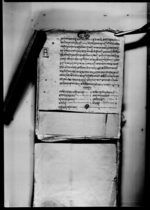A copy of a lālamohara from King Gīrvāṇayuddha exempting eight Kusles from corvée for their services at the temples of Paśupatinātha and Jayavāgīśvarī [VS 1863]
ID: K_0030_0024A
Edited and
translated by Axel Michaels
in collaboration with
Raju Rimal
Created: 2020-11-29 ;
Last modified: 2021-08-12
For the metadata of the document, click here
The accompanying edition, translation/synopsis and/or commentary are available under the terms of the Creative Commons Attribution-ShareAlike 4.0 International License
Abstract
This copy of a lālamohara from the king, who according to the date must have been Gīrvāṇayuddha, exempts eight Kusles from corvée for their services at the temples of Śrī Paśupatinātha and Śrī Jayavāgīśvarī. They are entitled to receive the offerings of mahāsnāna and mahābali pūjā. This office is hereditary.Diplomatic edition
[1r]
[Unknown seal] [Unknown seal] 1आगेविश्नुदासकुसल्यास्मेट्जना८कुसल्याकेअघीदेषीषाईआय़ा•2कोटोलरजागीरषेट्मुरी१५०मरमहसुलमाफ्गरीनीत्येसाजवेहा
3नश्रीपसुपतीनाथश्रीजये़वागीश्वरी•मावाजावजाउनुटहलमारा•
4षीअवउप्रान्त•तीमीहरूआठ्जनाकोडंडकुंडमरोअपुताली•जोभैआ
5उछसोश्रीपसुपतीनाथश्रीजये़वागीश्वरी•प्रतीगरीडीठावीसेट्ह
6रूवसीभंदारडाषीलगर्नुगरीतीमीहरूकोझारावेठ्वेगारी•उज्या
7उनी•पज्याउनीसागुन्याफागुमाफगरीमाहासनानमाहावली•
8दीय़ाकोभातषनीआठैजनालेमात्रषानु•अरुकसैलेदगावाजी•
9नगर्नुगरीतपसीलमाफीकटहलमारूजुरह्यासम्मतीमीहरूकोसं
10तानपरयें़तषोसमोसनगर्नुगरीवंधेजवाधीवक्स्यौआफ्नाषा•
11तीरज्मासंगटहलमारूजुरही•अघीदेषी•षाईआय़ाकोटोलको
12आईउपतीलीभोग्येगर•कसैलेअमालीकोलागनास्ती¯¯¯ ¯¯¯ ¯¯¯ ¯¯¯ ¯¯¯ ¯¯¯ ¯¯¯१
13तपसील
[table1]
| 1 | नाईक्याविश्नुदासकेझ्याली¯¯¯ ¯¯¯ ¯¯¯ ¯¯¯ ¯¯¯ ¯¯¯ ¯¯¯ | १ | नाईक्याधीर्जनारांसहनाई¯¯¯ ¯¯¯ ¯¯¯ ¯¯¯ ¯¯¯ ¯¯¯ ¯¯¯ | १ |
| 2 | कृश्ननाथसहनाई¯¯¯ ¯¯¯ ¯¯¯ ¯¯¯ ¯¯¯ ¯¯¯ ¯¯¯ | १ | अषीनाथसहनाई¯¯¯ ¯¯¯ ¯¯¯ ¯¯¯ ¯¯¯ ¯¯¯ ¯¯¯ | १ |
| 3 | सीवनाथझ्याली¯¯¯ ¯¯¯ ¯¯¯ ¯¯¯ ¯¯¯ ¯¯¯ ¯¯¯ | १ | जसनाथफेरी¯¯¯ ¯¯¯ ¯¯¯ ¯¯¯ ¯¯¯ ¯¯¯ ¯¯¯ | १ |
| 4 | कर्नाली¯¯¯ ¯¯¯ ¯¯¯ ¯¯¯ ¯¯¯ ¯¯¯ ¯¯¯ | १ | ढोलकी¯¯¯ ¯¯¯ ¯¯¯ ¯¯¯ ¯¯¯ ¯¯¯ ¯¯¯ | १ |
18इतीसम्वट्मीतीसदर¯¯¯ ¯¯¯ ¯¯¯ ¯¯¯ ¯¯¯ ¯¯¯ ¯¯¯[Unknown seal]
Translation
[1r]
[Unknown seal]
[Unknown seal]
Āge: [To] 8 Kusalyās including Viśnudāsa Kusalyā, who have long enjoyed [their] ṭola and the jāgīra land amounting to 150 khetamurīs, who have been exempted from paying taxes (mahasūla), and who have been assigned to the Śrī Pasupatīnātha [Temple] and the Śrī Jayevāgīśvarī [Temple] for serving and playing music regularly [every] evening and morning. Now the regulation: If judicial fines and penalties [or] escheat property are owed by [any] of you eight people, you shall from now on deposit them in the presence of the ḍiṭṭhā and biṣet officials in the treasury for the benefit of (pratī garī) Śrī Paśupatinātha and Śrī Jayevāgīśvarī; you shall be exempted from ujjyāunī pajyāunī1 , forced labour (jhārā, beṭha, begāra), [and] from sāune phāgu, [and] you eight people alone shall enjoy the cooked rice offered on the occasion of the mahāsnāna2 and māhābali3 rituals. No one shall act perfidiously [regarding this rule]. As long as you perform service according to the particulars (below), [no one] shall seize [these benefits] from you and your descendants. Be dutifully present in service and enjoy the income from the ṭola, which you have been enjoying since times gone by. No amālī shall claim this.
Particulars:
[table1]
| Nāike Viśnudāsa: jhyālī (cymbals) | 1 | Nāike Dhīrjanārāṃ: sahanāī (shawm) | 1 | |
| Kṛśnanātha: sahanāī | 1 | Aṣīnātha: sahanāī | 1 | |
| Sīvanātha: jhyālī | 1 | Jasanātha: pherī (trumpet) | 1 | |
| karnālī (trumpet) | 1 | ḍholakī (barrel drum) | 1 |
The era [and] date are valid.4
[Unknown seal]
Commentary
The document is a copy of a lālamohara presumably issued by King Gīrvāṇāyuddha Vikrama Śāha from VS 1863 since it comes together with a similar document exempting Kusles from corvée for playing musical instruments at the Śrī Cāmuṇḍā Temple of Bhaktapur (K_0030_0024B).
Playing music at the Paśupatinātha Temple has a long documented tradition going back to Pratāpa Malla’s inscription of NS 764 (1644 CE). For details see Ṭaṇḍana VS 2042 and Michaels 1994: 148–150.

